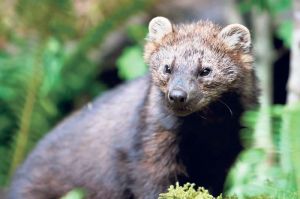Input sought on return of weasel-like fishers to Mount Rainier National Park
Photo provided by the Washington Department of Fish and Wildlife
Return of the fishers
The fisher, a member of the weasel family, is a candidate to be listed as an endangered or threatened species. The Washington Department of Fish and Wildlife is considering a project to reintroduce the fisher to Mount Rainier National Park.
Officials last week said they are seeking public input on a proposed plan to reintroduce the Pacific fisher to Mount Rainier and North Cascades national parks.
Absent from Washington since the mid-1990s, the Pacific fisher — a member of the weasel family that lives in low- to mid-elevation closed canopy forests with large trees and logs — is the only native carnivore that is no longer found within the Cascade Range of Washington state, according to Ken Hires, the Stehekin District interpreter for the North Cascades National Park Complex
In 1998, the state formally listed the fisher as endangered, and in 2004, the U.S. Fish and Wildlife Service listed the West Coast fisher as a federal candidate for listing as an endangered or threatened species.
To restore this species to its historical range in Washington, Mount Rainier and North Cascades national parks are proposing to team up with the Washington Department of Fish and Wildlife to reintroduce fishers to the North and South Cascades — the last two of the three major ecosystems statewide where successful fisher reintroduction is needed in order to meet Washington's recovery goals for this species, Hires said in a release.
Public comment on the proposed reintroduction may be submitted through Sept. 30.
During this time, comments may be submitted online at www.parkplanning.nps.gov/RestoreFisher or by mail to North Cascades National Park Complex, 810 State Route 20, Sedro-Woolley, WA, 98284.
Washington Department of Fish and Wildlife and Olympic National Park staff successfully reintroduced fishers at Olympic National Park from 2008-10.
"It is very exciting to partner with Washington Department of Fish and Wildlife and Mount Rainier National Park to reintroduce the fisher to this area," North Cascades National Park Complex Superintendent Karen Taylor-Goodrich said. "Reintroducing any species, much less one as wild as the fisher, is a complex and dynamic process and requires the collaboration of landowners and managers across the landscape to be successful.
--------------------------------------------------------------------------
OREGON FISH & WILDLIFE
THE PACIFIC FISHER
Description and Life History
the fisher, a member of the weasel family (Mustelidae), has a long body, short legs and a long, bushy tail. The head is broad and flat with a sharp, pronounced muzzle. The ears are broad, rounded, and low. Fur color varies from light brown to dark blackish brown, although the face, neck, and shoulders may have a lighter grizzled gray appearance. Often there are irregular white patches on the chest and underside. Fur length ranges from 30 millimeters (about 1 inch) on the stomach and chest to 70 millimeters (about 2.75 inches) on the back.Adults range in length from 90 to 120 centimeters (about 2.5 to 4 feet). Males weigh 3 to 6 kilograms (about 7 to 13 pounds); females weight 1.5 to 2.5 kilograms (about 3 to 5.5 pounds). Large feet, with 5 toes on all 4 feet and retractable claws, enable fishers to rotate their hind paws almost 180 degrees, allowing them to run down trees head first like a squirrel. Central pads on the hind paws have circular patches of coarse hair which are associated with plantar glands. These glands produce a distinctive odor believed to be used for communication during reproduction. It is estimated that fishers live up to 10 years. They are solitary animals except during the breeding season (late February through April).
Fishers are opportunistic predators that hunt exclusively in forested habitats where prey is abundant and vulnerable to capture. Their diverse diet includes birds, porcupines, snowshoe hare, squirrels, mice, shrews, voles, reptiles, insects, carrion, vegetation, and fruit. Their name is misleading since fishers do not actually catch fish. The name may have come from early European settlers who noted the fisher's similarity to the European polecat which was variously known as a fitchet or fitchew.












No comments:
Post a Comment